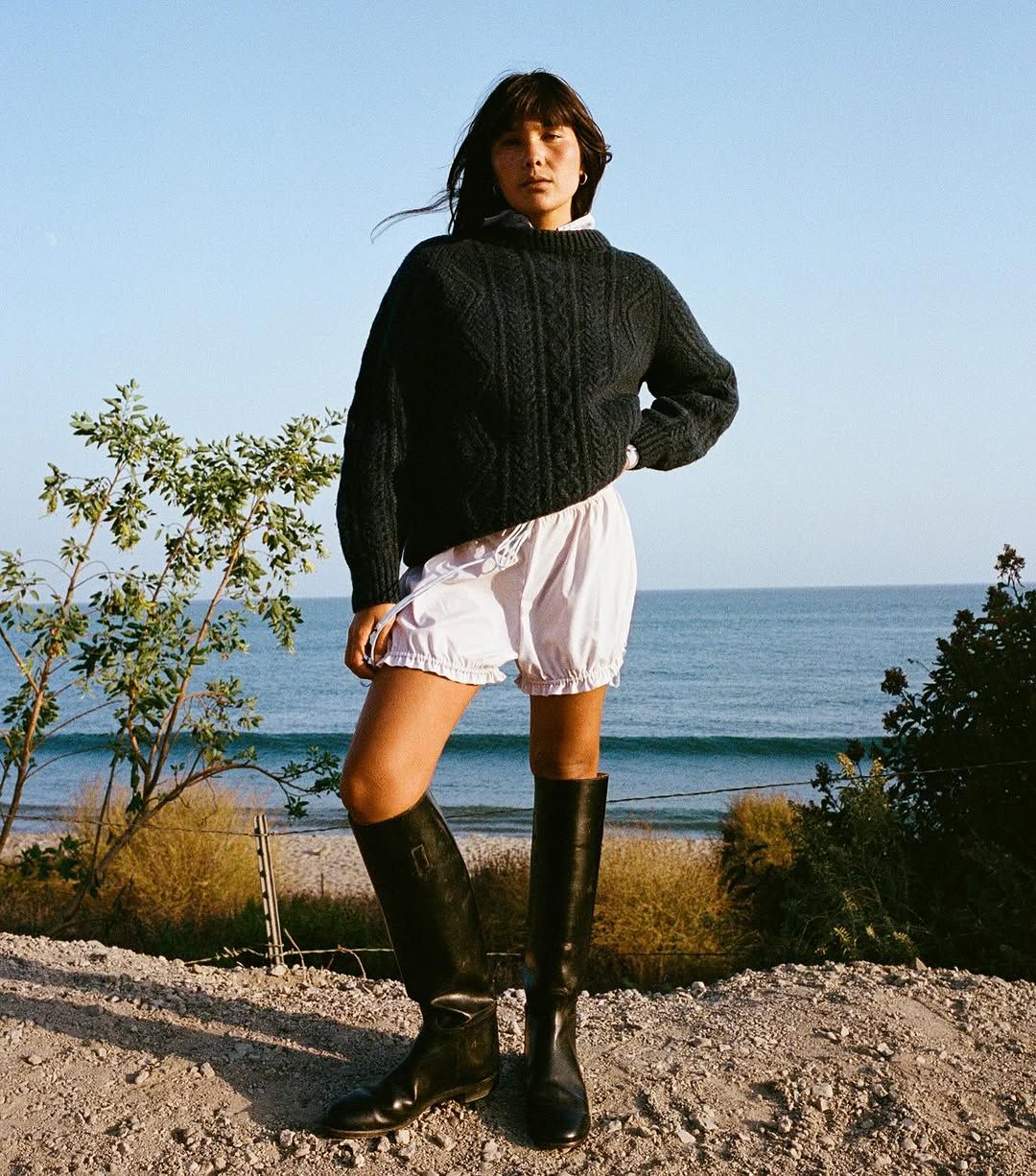Salter House offers poufy bloomer pants that nip at the ankles. Here, it is shown worn under a dress. Photo: Instagram/Salter House
They billow like paper lanterns. They can reach the ankles, or cinch into two large puffballs around the upper thighs.
They may not be sexy to anyone but the person who’s wearing them – and that’s sort of the point.
“It’s a bit of a rebellious thing,” said Charlie Hourston, the founder of the Los Angeles-based label Charlie Beads, which has sold more than 2,000 of these pants, known as bloomers, in the past 18 months.
Other riffs on the hot-pant-like shape include a terry cloth bloomer by Suzie Kondi and a cut in velvet by Colleen Allen, two New York City labels.
Customers often note that their romantic partners probably won’t understand the look or may even find it unappealing, said Hourston, 25.
She considers that to be one of the design’s selling points: “Even if they’re not flattering, they’re empowering.”
Divisive though they may be, bloomers have reached a new saturation point this season, hitting racks at mall chain stores, rippling down high-fashion runways and cropping up on the social media feeds of independent clothing labels like Lauren Manoogian and Chelsea Mak.
They can range in price from US$30 (RM133), as is the case with a butter-yellow pair from Urban Outfitters, to more than US$6,000 (RM26,601) – the price tag on Alaia’s most expensive take on the silhouette.
Read more: 'Why not?': This Japanese designer creates shoes that come with metallic teeth
Much like the wearers of winter’s oversize sweaters, many of the women drawn to these pants say they are in search of a post-male gaze femininity.
Some are looking to telegraph a certain intellectual outlook on fashion.
In January, Repossi, 39, wore a pair of Alaia’s voluminous trousers, priced at US$6,400 (RM28,374), to a dinner hosted by the brand.
On a recent scroll through social media, Sandeep Salter, 37, was surprised to see a fast-fashion version of bloomers flash across her screen.
The style was familiar to Salter, an owner of Salter House, a New York boutique that sells housewares and clothes that have come to define a certain urban Bo Peep aesthetic.
Since 2021, her store has turned out poufy bloomer pants that nip at the ankles as part of its in-house fashion label.
That design has become popular with workers at Stissing House, a Hudson Valley, New York, restaurant with a similar cottage-chic sensibility.
Kaitlin Pearce, the restaurant’s director of feasts, wears hers multiple times a week for dinner service and said they can evoke an unexpected mix of emotions – making her feel both like an American Girl doll and an arbiter of social defiance.
For Pearce, 35, the pants have added appeal because of their feminist history.
While the shape is derived from Ottoman-era salvar pants, which in the mid-19th century became fashionable among European women, in the US the garment is most closely associated with suffragist Amelia Bloomer, said Matthew Yokobosky, the senior curator of fashion and material culture at the Brooklyn Museum in New York.
“They were looking for more equality and somehow started associating freedom of clothing with freedom of choice,” Yokobosky said.
He acknowledged the style as among the first feminist designs.
The most dramatic of today’s bloomers closely resemble those worn by Bloomer herself.
Often referred to as balloon pants, the giant bottoms plume with excessive quantities of fabric to create an exaggerated silhouette that was last popular in the 1980s.
Read more: What you need to know about corduroy, a workwear fabric that's now high fashion
Alaia designer Pieter Mulier is responsible for the most extreme balloon pants, presented as part of the brand’s Spring 2025 runway show.
Many of them were paired with cropped tube tops and minimal makeup – putting the spotlight almost solely on Mulier’s giant pant designs.
At Nordstrom, taffeta versions of the French label’s balloon pants, priced at US$2,150 (RM9,532), are quickly selling out.
Rickie De Sole, the store’s vice president, fashion director, said customers were drawn to their novelty, which “gets you talking".
The shape can also be purchased at more approachable price points from brands like Free People and Anthropologie, which share a parent company.
At the former, sales of the brand’s antique-y Forever Young bloomer pants have “exploded”, according to Ana Hartl, the company’s chief creative officer.
First introduced last year, the design is now available in some half-dozen colours.
Chelsea Mak, whose namesake brand is based in Los Angeles, calls her take on the style “rain joggers”.
Mak says she finds the pants appealing because they are visually akin to ankle-grazing skirts but offer more comfort and ease of movement.
“In my own twisted, modern way I wanted to look feminine like wearing a big skirt but needed the mobility of a pant,” said Mak, 40.
“It’s bohemian and feminine without stepping into a big prairie skirt.” – ©2025 The New York Times Company
This article originally appeared in The New York Times.








